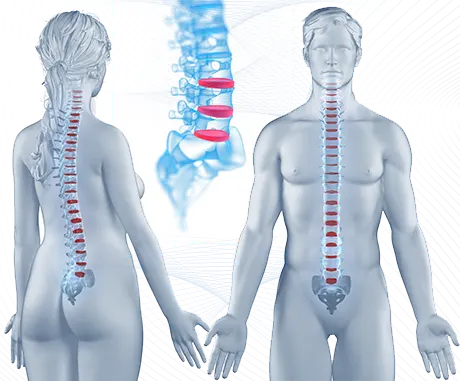
Guide intervertebral discs · Spine and back pain
Back pain is a frequent reason for medical consultation, inability to work and early retirement due to partial or complete reduced earning capacity.
When the back hurts
What can be done in case of disc complaints and back pain?
Spine and back complaints · Introduction
The human spine (columna vertebralis) consists of intervertebral bodies, ligaments and intervertebral discs. It functions as a flexible support of the body. A mobile segment is formed by 2 adjoining vertebra, 1 intervertebral disc and the stabilising ligaments and tendons. A pressure-elastic intervertebral disc is situated between all vertebrae with the exception of the topmost 2 cervicals and the sacral and coccygeal vertebrae which are coalesced.
The human spine is formed by:
Pain of muscles, nerves, bones and other structures of the back or spine is defined as back pain (dorsalgia). Back pain – together with osteoarthritis – is one of the most widespread chronic pain syndromes.[1] In nearly every third case, the complaints keep returning.
Classifcation of back pain
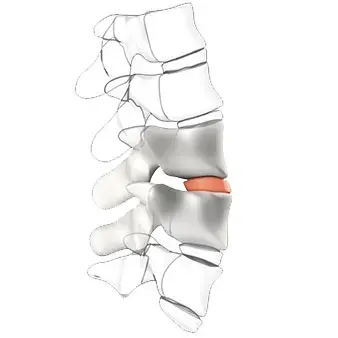
Intervertebral discs · What are these?
Intervertebral discs form the connection between 2 vertebral bodies. They consist of an inner soft pulpous nucleus (nucleus pulposus) that is surrounded by a fibrous ring with cartilaginous tissue (anulus fibrosus) and the cover plates consisting of hyaline cartilage that extend into the vertebral bodies. The pulpous nucleus is formed by a colloidal tissue with few cells but a high water content.
Intervertebral discs are numbered among the bradytrophic tissues. They have few or no blood vessels (blood capillaries) and therefore only a very weak metabolic activity. They are supplied via diffusion, that is a physical process in which the necessary exchange of liquids happens through pressure at stress. This way, nutrients (like proteins, enzymes, minerals) get into the cells of the discs and waste substances are excreted at the same time.
Due to the daily stress, the intervertebral discs lose liquid during the day which they regenerate at night. If persons do not exercise sufficiently, this process can be disturbed with consequential disc complaints. On general, the amount of liquid in the intervertebral discs resp. the pulpous nucleus decreases with advanced age. That is why signs of wear and complaints are more frequent in later life. Beginning signs of wear also show in an increasing number of younger people because of frequent one-sided stress and a lack of exercise.
Among others, symptoms of disc degeneration can be:
Vicious circle back pain
Chronic pain [2] has a huge impact on the life of people affected. Unsuccessful therapy attempts often massively limit the quality of life and cause a depressed mood, anxiety and a reduced performance capacity. Some damages can be compensated by healthy intervertebral discs. Regeneration takes a long time as cartilage tissue has a slow metabolism. Disorders of these endogenous repair mechanism, i. e. reduced metabolic activity, can decrease elasticity, height and resilience of the intervertebral discs with ususally very painful consequences.
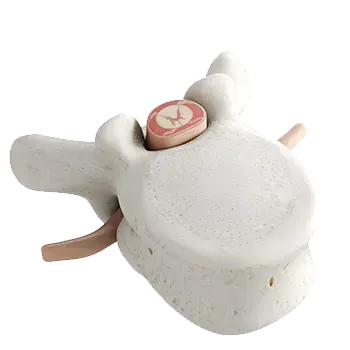
Common back complaints
Frequent disorders that can lead to severe pain which can be a massive restriction of daily life are:
Disc protrusion
A degenerated and brittle fibrous ring can not hold the pulpous nucleus in place. Consequently, the intervertebral disc can protrude into the vertebral canal and put pressure on the spinal cord and nerves which can result in intense pain.
Lumbago
An intense paralysing pain in the lumbar part of the spine after a rapid movement can be a symptom of lumbago. Patients can hardly move and take on a relieving posture. Reasons for chronic lumbago are often degenerative changes on intervertebral discs and vertebral joints of the lumbar spine.
Disc prolapse
When stress causes tearing of the fibrous ring, the pulpous nucleus can leak into the spinal cord and nerve cords running inside are compressed. This results in strong, radiating pain (even in times of rest) and disorders of sensibility. In severe cases, the urge to defecate and urinate can be disturbed and paralysis is possible.
Osteochondrosis
Changes on the osseous structures of the spine as a result of the degeneration of intervetebral discs are called osteochondrosis. If ossification progresses, the mobility of the spine can be impaired to such an extent that the affected part of the spine stiffens completely. This causes permanent intense back pain at nearly every movement and also at rest.
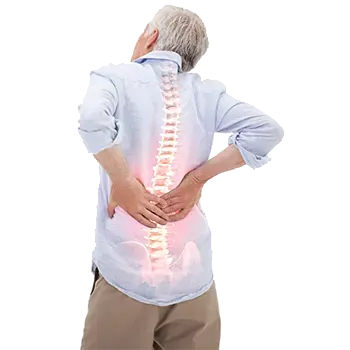
Back pain · Can be a warning sign of ...
Back pain should never be taken lightly as it can be a warning sign of other diseases. Patients should consult a doctor if the following symptoms appear:
Osteoporosis
Back pain can be a sign of an early grade of osteoporosis when it appears in women in an advanced age. The pain is sometimes not taken seriously but considered as lumbago. But the differentiation is important as an early diagnosis of osteoporosis offers the possibility of a targeted treatment, for example with MBST magnetic resonance therapy.
Morbus Bechterew
If back pain persists for more than 3 months and worsens when lieing down or in the mornings, it might have an inflammatory cause which can be a sign of Morbus Bechterew. An early start of therapy can help to stop the progressive destruction of the joints and a massive scoliosis.
Treating damages and complaints of the spine
Many therapy options aim first and foremost at the reduction of pain. Pain killers, anti-inflammatory drugs or muscle relaxants are administered by injection or infusion. The medicinal therapy is accompanied by physiotherapy. But the degeneration of the intervertebral discs progresses, increasing the risk of chronification. Even surgery may not always help in these cases.
MBST in the treatment of disc complaints and back pain
Molecular biophysical stimulation
The non-surgical MBST magnetic resonance therapy has another approach and besides reducing the pain aims at a regeneration of the damaged cells of spine and intervertebral discs. The metabolism is the basis of all vital processes in the body and needs a lot of energy. Energy, that is also processed in the intervertebral discs and vertebral bodies for , protection and repair of the tissue. The cells of the intervertebral discs are supplied via diffusion because only the outer part of the fibrous ring contains blood vessels. In the process of degeneration the cells are lacking energy, among other things, to compensate defects with an intensification of the metabolism. Damages can not be repaired anymore [3] so that the intervertebral discs lose their ability to fulfill their function. This is the starting point for MBST therapy.
The MBST therapy system has been developed to transfer energy to the osseous and the cartilaginous tissue of the spine in a targeted manner. Its objective is to increase the metabolism and thereby re-trigger the body’s own repair mechanisms and regeneration processes. Besides reducing pain, the objective of the MBST magnetic resonance therapy is to improve mobility and especially to prevent spinal surgery.
MBST therapy is based on the physical principle of magnetic resonance, in which hydrogen nuclei take up energy and then release it again partly into the surrounding tissue. Scientific data suggests that MBST magnetic resonance technology stimulates various biophysical processes and triggers anti-inflammatory and pain-relieving effects.[4,5,6] Damaged cells shall be influenced in such a way that natural regenerative processes can be triggered. The treated tissue shall regain functionality as completely as possible.
The advantages of MBST magnetic resonance therapy in cases of back pain at a glance:
[1] Niv et al. 2003, Pain 105, 387–392 · [2] Nilges & Nagel 2007, Dtsch med Wochenschr 132(41), 2133–2138 · [3] Salomonowitz et al. 2011, Z f. Orthopädie und Unfallchirurgie, 149, 575–581 · [4] Temiz Artmann et al. 2005, Methods and Findings in Experimental and Clinical Pharmacology, 27(6),391–394 · [5] Melzer et al. 2003, Fachkrankenhaus für Orthopädie · [6] Steinecker-Frohnwieser et al. 2014, Journal of Orthopedics and Rheumatology 9/2014 · [7] Kullich/Melzer 2018, Scientific evaluation of the MBST Magnetic Resonance Technology regarding the therapeutic potential and proof of clinical efficacy

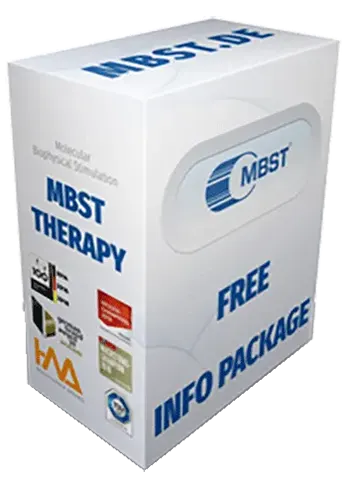
MBST therapy for intervertebral discs · Overview